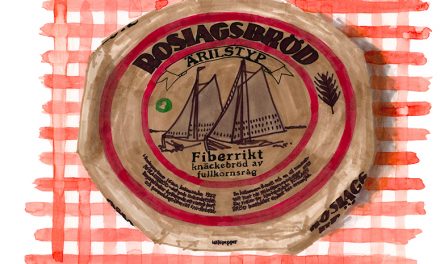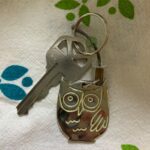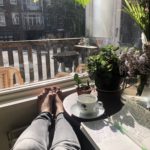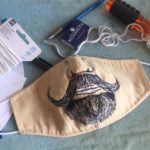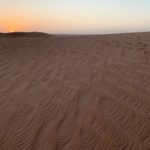
Francesca Aikman is a young artist from the North West of England who lives and works in Amsterdam. She arrived directly after finishing a degree in Fine Art at university in Preston to take up a residency at OT303, and, without her really realizing or planning it, Amsterdam became home. Recently, she has been making small, intimate ink paintings of streets in Amsterdam. These colourful works are all created using black ink, which is then allowed to divide into different colours when dropped onto wet paper (paper chromatography). They are beautiful depictions of fleeting moments in time; the moment when light hits a surface in a particular way.
Francesca and Hiraeth Art Editor, Rowena Dring, sat down over tea to talk about home, life and work.
RD: …There is an acceptance about art here that I didn’t find in England at the time when I was there, which was 20 years ago. In Amsterdam, I’ve never felt I had to explain my reasons for being an artist as I did in England. It’s just accepted here in a way that I guess that it still isn’t in the North of England?
FA: That’s really true. There’s a big confusion over there, especially in Preston, where I’m from. They have got a huge central museum, like a city hall building, which is the arts museum, but it’s just full of the same things that have been hanging there for 50 years. I have all these ideas… why don’t [they] showcase the up and coming? Or the student work there, get the young people involved instead of just celebrating the past all the time? But they don’t really think like that.
RD: That’s the difference about being in a city… Amsterdam is a small city, but it is still very much a City. There’s a great international climate with the big museums.

FA: There is lots to see and lots of inspiration. There’s a lot going on and lots of opportunities. It was just by chance, from chatting to somebody in a café for five minutes that I found my last studio. He was drawing and I was intrigued because it’s just nice to see someone drawing. So we swapped some conversation and business cards. Then, two years later I got asked through another friend if I would be interested to be part of a new gallery space which could be also be a working studio space? It was new and there was an open call to artists who wanted to display their work and have an open space in which to paint. It was quite random, so I turned up and it was the same guy I had spoken to two years previously for all of five minutes who stood outside with a big smile on his face. It turned out that a lot had happened in the two years that had passed. We had a great couple of years with a gallery close to the flower market in the center where it was just this random meeting of people. No one knew each other at all, we just wanted a space to work and exhibit. That was a really fantastic time…even just sharing a space with other artists…everyone with different ideas and perspectives… I don’t know! All this kind of stuff just happened effortlessly, really.
RD: In a way that you don’t think it would have happened in England?
FA: No, it wouldn’t have done, because here every single person had come from a different country, with completely different backgrounds, and we were all just meeting in the same space.
RD: To some degree, I think it makes people more open when you are away from home. You leave certain inhibitions or preconceptions behind you.
FA: That’s true.
RD: Your work has changed quite a bit since you left England?
FA: Yes. At University I was doing large-scale textured paintings. I just wanted to go as big as possible while I had space at the time. It was all about layering papers and things and then painting with ink. I still use ink a lot. Previously it was about texture and scale, but then from moving around, moving from house to house to house whilst being here (in Amsterdam), it just wasn’t realistic to be painting so large. So now I’m making smaller ink drawings on paper.
RD: There is also something as well that fits with the scale of Amsterdam about making smaller pieces. The scale of (art)work is always dependent on the environmental necessities of where you are living or working.
FA: I find it’s actually quite easy. All I actually need is a paintbrush, a pencil and some ink and I can paint anywhere. Oh, and a bit of a table.
RD: It has a nice economy to it.
FA: Exactly!
RD: So, in your most recent ink drawings that I am looking at now, they are all about the textures of the Amsterdam houses. Amsterdam is a city with a lot of textures…all the different facades, the details, different bricks, different surfaces…can you say anything about what draws you to paint the canal houses?
FA: For me, it’s just totally different from what I’m used to. Back in England you have big blocks of buildings, you will have a street of houses and they all look exactly the same. Just with a different number on the door. Whereas here every single house has got completely different details, character…that is always quite interesting.

RD: After years of living here, pretty much every day whilst cycling I will see a new detail, a different cornice, just something curious that I haven’t seen before on my regular routs through the city.
FA: And also how crooked everything is in the center of Amsterdam! It kind of helps to give me a freedom in making the work. I don’t feel so strict and exact because actually the houses are not exact and strict. So, that was something quite enjoyable along the way. But, mainly, all my works (even when I was doing the big works on canvas) they were all about light, so…I find it quite fascinating looking at how the light falls on surfaces and objects.
RD: The light in Amsterdam can be astounding. There is a beautiful movie, from around the time I first came here in the ’90’s, called, Hollands Licht. It’s a documentary about the light in the Holland, and explores the idea that the light here is just different to anywhere else in the world. I think this idea comes from the wetness and the amount of water. What I find incredible in Amsterdam is how the light is reflected off the canals and the Ijsselmeer, bouncing up onto the clouds then reflected down again. We live by a big canal, and some mornings the light bounces off the canal, reflecting the moving surface of the water across our ceiling. It was a very strange experience when I first saw it. There is just so much more light here that I’m used to in England or Ireland.
FA: It’s the same for me.
RD: I’m really interested in this beautiful image from Leidseplein with the tram tracks, the silhouettes of figures walking into the light, with the light bouncing off the metal tram tracks, and it has a feeling that the metal is wet.
FA: It actually was. It was from, literally, this time of the year, October, when everything starts to change. It’s still sunny out there but it rains a lot and it starts to get colder. You get this time in October when the lighting is kind of curious. You can have a dull kind of greyish scene, but then the light kind of…I don’t know, it’s because of the wetness, when the light comes through everything is just really bright amongst the greyness…
RD: There is a weird sharpness too it.
FA: That was my walk home from work when I used to live on Leidseplein. It’s one of those moments you know when the sun is a that angle when you can’t actually see anything in front of you because the light has turned everything to a silhouette.
RD: Light obscures as well as revealing. It a really beautiful piece. And the other piece we were looking at, the one of the house-boats… do you remember which canal that was on?

FA: It’s near Rembrandtplein, up on the Amstel near the art shop, the Vlieger. Which must be quite a busy place to live on a houseboat.
RD: I’ve never been on a houseboat, and I wonder what it must be like, on this boat, opening your curtains and looking out directly across the water?
FA: I imagine it’s quite chaotic around there at nighttime! There is so much nightlife around those parts. But it seems so peaceful inside, on a boat.
RD: very cozy… what I love about the piece is how you have the really recognizable 17th century canal houses, but then in front you have the modern, simple houseboat. You know, for years living on a houseboat in Amsterdam was just an alternative way of living in the city and being at home in the city…. for a long time you didn’t pay city taxes on a houseboat so you could live in the center of the city for something like 12 guilders mooring fees. It was such a cheap way of living in the city. They were kind of floating caravans and an alternative community. That all changed just after I moved here. The city banned new houseboats that weren’t built on actual boats. The boats all got fancier and bigger, floating apartments in the city. In a way I find it a shame that a big part of that grunge level of life has been moved out of the city center.
FA: Well, you never know…there’s still quite a bit of it..
RD: ha! Yes, still quite a lot exists. But I think my idea of what is the city center (inside the four central canals) is a bit outdated.
FA: It’s nice hearing that, about two different ways of inhabiting the city…to imagine being in there with these really expensive houses right next to you…it’s a complete contrast. I’m trying to paint a feeling of calmness with all of these ones specifically about light. What I mean with that is I’m trying to capture when the light shines so vividly into a really chaotic, busy scene…for me it creates a balance and makes everything peaceful. I don’t know what that is but in my mind when the light is just so dominant it kind of distracts…it distracts me anyway from everything that’s going on around me; from all the noise, all the busyness. It quite busy Amsterdam in the center. There are lots of people, tourists everywhere. And with the houseboat painting it’s the same concept, for me that’s a busy area and it captures the light coming up off the water. I imagine being in the boat chillin’ and looking at the light, feeling the calmness in the middle of the chaos.
***
Listen to their full interview on tomorrow’s podcast, Episode 24: Calmness Against Chaos. Francesca and Rowena will also both have work on display at the upcoming storytelling event on 25 November at Butcher’s Tears, with signed, limited edition prints available for purchase!




